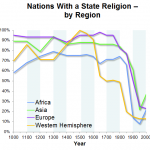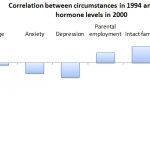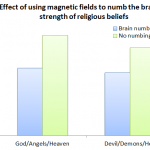![By Eric Wassermann, M.D. [Public domain], via Wikimedia Commons](https://wp-media.patheos.com/blogs/sites/492/2015/05/Transcranial_magnetic_stimulation-300x270.jpg)
Recently, Cristiano Crescentini at the University of Udine in Italy, and colleagues, have been running a more sophisticated version of Persinger’s original experiments, with some fascinating results.
They used something called the ‘Implicit Association Test‘ as a subtle way to measure how strongly their subjects (14 Catholics) identified with religion. At the same time, they used powerful electromagnets to apply pulses that were either continuous or intermittent.
They found that the intermittent pulses made people significantly less likely to identify themselves as religious.
Crescentini and colleagues argue is that these magnetic pulses make the parietal lobe more active. It fits with an earlier study by the same team in which inhibiting this part of the brain made people more religious.
What seems to be happening is that this part of the brain is closely linked to our sense of location. By boosting its activity, the subjects found it more difficult to experience ‘extended self-awareness’, in which it feels as though the body transcends conventional physical limitations and people feel at one with the universe.
In other words, by ratcheting up or down our awareness of our own bodies, we can increase (or decrease) quasi-mystical sensations.
![]() Crescentini, C., Di Bucchianico, M., Fabbro, F., & Urgesi, C. (2015). Excitatory stimulation of the right inferior parietal cortex lessens implicit religiousness/spirituality Neuropsychologia, 70, 71-79 DOI: 10.1016/j.neuropsychologia.2015.02.016
Crescentini, C., Di Bucchianico, M., Fabbro, F., & Urgesi, C. (2015). Excitatory stimulation of the right inferior parietal cortex lessens implicit religiousness/spirituality Neuropsychologia, 70, 71-79 DOI: 10.1016/j.neuropsychologia.2015.02.016











